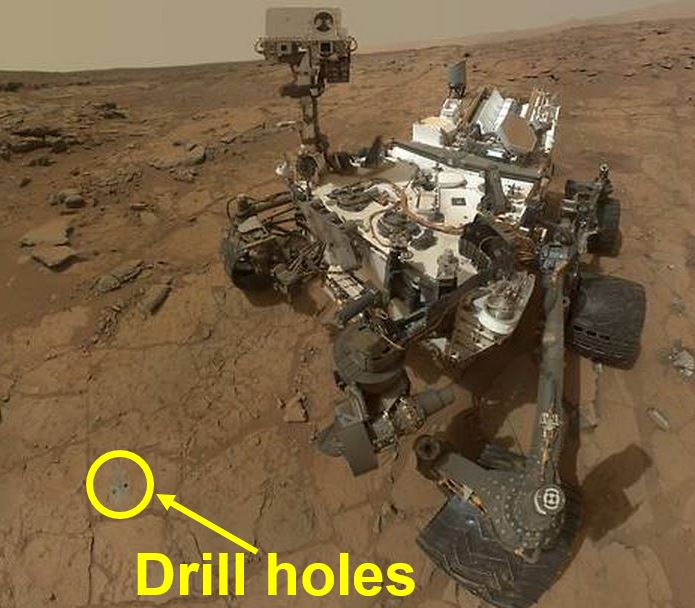NASA’s Curiosity rover has detected life-sustaining nitrogen on Mars, further adding to the evidence that the Red Planet was habitable for life. Nitrogen is a key building block of amino and nucleic acids, crucial for life on Earth.
A team of scientists using the SAM (Sample Analysis at Mars) instrument fitted onto NASA’s Curiosity rover said nitrogen was detected when a sample of Martian sediments was heated.
The element was detected in the form of nitric oxide, and was released from the breakdown of nitrates during heating. On Earth, plants assimilate nitrogen directly in the form of nitrates that are present in soil from natural mineral deposits, animal waste, artificial fertilizers, or organic decay (as a product of bacteria).

In this self-portrait of NASA’s Mars rover Curiosity, you can see (in the yellow circle) where it used its drill on the rock target ‘John Klein’. (Image Credit: NASA/JPL-Caltech/MSSS)
All forms of life on Earth need nitrogen. It is used in the building blocks of larger molecules such as DNA and RNA, which encode the genetic instructions for all living beings, as well as proteins, which are used to build structures like nails and hair, and accelerate or regulate chemical reactions.
However, both on Mars and Earth, atmospheric nitrogen is locked up as N2 (nitrogen gas) – two atoms so strongly bound together than they do not react easily with other molecules.
Nitrogen atoms must be ‘fixed’
Nitrogen atoms have to be ‘fixed’ (separated) so that they can participate in the chemical reactions required for life.
On our planet, certain organisms are capable of fixing atmospheric nitrogen, and this process is vital for metabolic activity. Small quantities of nitrogen can also be fixed by lightning and some other energetic events.
NO3 – a nitrogen atom bound to three oxygen atoms – is a source of fixed nitrogen. A nitrate molecule can join with several other molecules and atoms. This class of molecules is called nitrates.
Scientists at NASA’s Goddard Space Flight Centre said there was no evidence suggesting that the fixed nitrogen molecules they found were created by living organisms. Mars’ surface is inhospitable for all forms of life as we know it. Rather, they believe the nitrates are ancient, and probably came from non-biological processes such as meteorite impacts and lightning in Mars’ very distant past.
Mars was probably once hospitable
Mars has features resembling dry riverbeds and minerals that only form in the presence of liquid water, suggesting that the Red Planet used to be more hospitable a long time ago.
The Curiosity scientists have found evidence that other ingredients required for life as we know it, including liquid water and organic matter, were present on Mars at the Curiosity site in Gale Crater some billions of years ago.
The researchers wrote about this in the academic journal Proceedings of the National Academy of Science (citation below).
Lead author Jennifer Stern of NASA’s Goddard Space Flight Center in Greenbelt, Maryland, said:
“Finding a biochemically accessible form of nitrogen is more support for the ancient Martian environment at Gale Crater being habitable.”
Evidence for nitrates in scooped samples of windblown sand and dust were found by the team at the ‘Rocknest’ site, and also in samples drilled from mudstone at the ‘Cumberland’ and ‘John Klein’ drill sites in Yellowknife Bay.
Nitrates probably widespread across the Red Planet
Ms. Stern believes nitrates are probably widespread across Mars, given that the Rocknest sample is a combination of dust blown from distant regions on the Red Planet, plus more locally sourced materials.
From the drill site samples, the scientists estimate that there is the equivalent of up to 1,110 parts per million nitrates in the Martian soil. They believe the mudstone at Yellowknife Bay formed from sediment deposited at the bottom of a lake.
The rover team had previously described clear evidence of an ancient, habitable environment at Yellowknife Bay – fresh water, major chemical elements required by life, such as carbon and “potential energy sources to drive metabolism in simple organisms.”
The rover instruments first heated the samples to release molecules bound to the Martian soil. Then some of the gases released were diverted to the SAM instruments to be analyzed.
Two instruments – a mass spectrometer and a gas chromatograph – identified various nitrogen-bearing compounds.
The instruments detected NO (nitric oxide – one atom of nitrogen bound to an oxygen atom) in samples from all three sites.
As nitrate is one nitrogen atom bound to three oxygen atoms, the scientists believe that most of the NO probably came from nitrate that decomposed when the samples were being heated for analysis.
Some of the compounds in the SAM instrument may also release nitrogen when the samples are heated. However, the amount of NO detected was over twice the amount that just SAM could ever produce, Ms. Stern said.
Hence, the team believes there are nitrates present on Mars.
Ms. Stern said:
“Scientists have long thought that nitrates would be produced on Mars from the energy released in meteorite impacts, and the amounts we found agree well with estimates from this process.”
Citation: “Evidence for indigenous nitrogen in sedimentary and aeolian deposits from the Curiosity rover investigations at Gale crater, Mars,” Jennifer C. Stern, Brad Sutter, Caroline Freissinet, Rafael Navarro-González, Christopher P. McKay, P. Douglas Archer, Jr., Arnaud Buch, Anna E. Brunner, Patrice Coll, Jennifer L. Eigenbrode, Alberto G. Fairen, Heather B. Franz, Daniel P. Glavin, Srishti Kashyap, Amy C. McAdam, Douglas W. Ming, Andrew Steele, Cyril Szopa, James J. Wray, F. Javier Martín-Torres, Maria-Paz Zorzano, Pamela G. Conrad, Paul R. Mahaffy, the MSL Science Teams. Proceedings of the National Academy of Science. Published on March 23, 2015. DOI: 10.1073/pnas.1420932112

